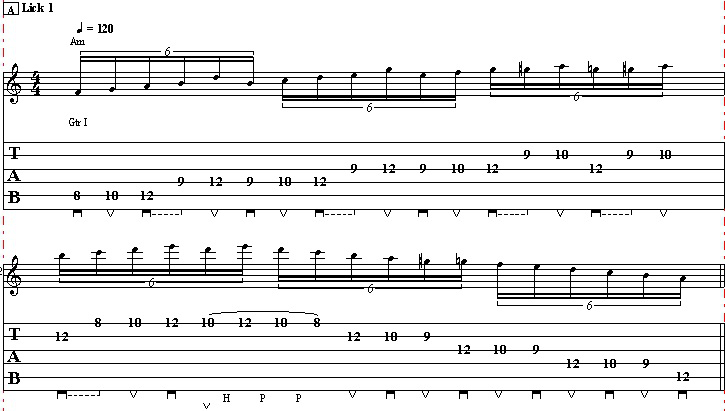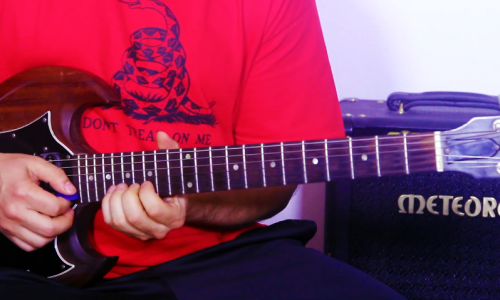Learn to play an easy bluesy-rock lick in A minor with Guitar Control instructor Darrin Goodman. Be sure to get the tabs for this killer video lesson so you can easily follow along.

Introduction
Hey everybody how’s it going? This is Darrin with GuitarControl.com bringing you this video lesson. Today I want to show you a pretty easy kind of bluesy rock lick that’s just based out of the minor pentatonic scale. I’m doing this in the key of A, but it’s a movable shape, so you’ll be able to transpose it around to wherever you want within reason, but there’s one part that you do have to make a little bit of a compensation for, but we’ll talk about that when we get there. So be sure to click on the link in the description for the tabs and let’s get close up and take a look and Learn To Play An Easy Bluesy-Rock Lick In A Minor.
Easy Bluesy-Rock Lick In A Minor
All right so if you’ve if you’ve been following other lessons that I’ve done on the pentatonic scale and licks used from the pentatonic scale some of this stuff may seem familiar to you but this is just because I want to show you how you can just take all of these different ideas and you can combine them together and make other licks out of it. So like I said we’re doing this in the key of A, but you really can move it around because what we’re playing here is all based out the minor pentatonic scale out of pattern 1… All right so we’re going to start off we’re going to rake into this first note. So what we want to do here is heavily palm mute so we’re just kind of getting almost like a percussive sound, it’s almost just kind of a noise, but it really just puts a big accent on the first note. So what you’re going to want to do is put your first finger onto the fifth fret of the high E string and then your fourth finger onto the eighth fret of the high E string and then we’re gonna just rake into this starting on the D string and then we’re going as soon as we pick the high E string we’re gonna pull-off… All right so if this raking thing is new to you it takes some practice to be able to do it halfway decent. Sometimes I’ll do it really nice and other times it doesn’t really get executed well and it seems like if I’m not really thinking about it and not trying it comes off a lot smoother. So what we’re going to do here is we’re going to rake into this and then do that pull-off and then we’re going to follow that with the 8th fret of the B string… back to the fifth fret of the high E string… then we’re going to go to the B string and we’re going to put our first finger on the fifth fret of the B string and our fourth finger on the eighth fret and we’re going to pick and pull-off… and then to the eighth fret of the G string and back to the fifth fret; so that’s the first measure… So if you know the scale then you’ve probably already seen that like hey you’re hitting a note that’s wrong… it should be here… but I’m going here and I’ve raised it a half step because that it’s the diminished fifth, it’s the fifth note of the scale flattened a half step which is what they refer to as the blue note… and then back there that’s the first measure. And then going on to the third measure we go back to the G string and we’re going to go eight seven five to the seventh fret of the D string with my third finger back to the seventh fret of the G string. So I’m just going to take that third finger and roll it up and then back down and then to the fifth fret of the G string and that’s the first two measures… And then starting on the third measure we’re gonna go to the D string; first finger on the fifth fret, third finger on the seventh fret and we’re gonna pick that and do a pull-off to the seventh fret of the A string and back to the fifth fret of the D string. Then we’re going to go back to the seventh fret of the A string and then to the sixth fret and then to the fifth fret and we’ve got this little chromatic movement there and then slide down to the third fret… And then from there to the fifth fret of the low E string back to the third fret of the A string and then a hammer-on to the fourth fret and then this is where it’s kind of kind of a stretch in this key… Now we’re gonna go all the way up to the seventh fret of the D string and then follow that which is the open A string. Now you can do it in a different key that would be easier, if we’re doing it in the key of E they are closer together, but like I said you can move this around wherever you want. Now since that last note is an open string the only way that you’re going to be able to play it with the open string is either in E or A, but if you wanted to do this in a in a different key you would just do that last note in a different place. So here in A we could just go to the fifth fret of the low E string because that’s an A. So if we wanted to do this say here in the key of B, that note would just be here… When you do that hammer-on and then you go up you know that big stretch up to the D string it’s the note that it’s a half step away from where your middle finger was or if you just know where your notes are it’s the first note of the pentatonic scale. So if we’re doing it here… like that… now it is kind of awkward to grab that, but it works and it’s easier and I like the way that it sounds better with an open string, but that’s just a personal preference.
Conclusion
All right so there you have it. A relatively simple bluesy rock lick that is interchangeable as far as you can move it around into whatever key and then if you were going to use this to improvise over like a backing track or something you may have to adjust the tempo in which you play it or the timing and you may have to put space between some of the notes or move some of the notes together to kind of make it fit the way that you want. So my advice would just to learn the sequence and then just play around with it and make it your own. You can change the timing and maybe take notes away or add in other ones and just kind of do whatever you want. So if you like this blues-rock lick lesson be sure to give me a thumbs up and leave a comment down below if you have any questions about this or other guitar related topics. If you’ve not already done so please subscribe to the channel and hit that notification bell so you don’t miss any of the content that we upload throughout the week. Well that is all I have for you today. Thanks for watching Learn To Play An Easy Bluesy-Rock Lick In A Minor and have a great day.



